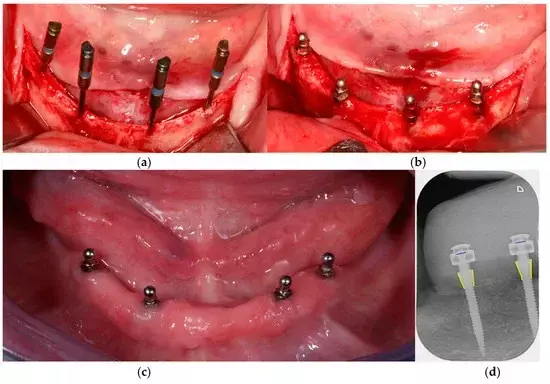Nonguided implant placement approach okay for placement of One-piece mini-implants to support mandibular overdenture: Study

Nonguided implant placement approach okay for placement of One-piece mini-implants to support mandibular overdenture suggests a study published in the Clinical Oral Implants Research.
A study was done to assess the relative position of mini-implants to retain a mandibular overdenture, according to the surgical protocol, technical and anatomical factors.Mandibular cone-beam computed tomography (CBCT) scans were analyzed for 73 patients who received four one-piece titanium-zirconium mini-implants. Drilling was performed using a 1.6 mm needle drill and a 2.2 mm Pilot Drill, according to the bone density with a surgical stent. Post-insertion CBCT images in DICOM format were analyzed using the E-Vol-DX software with BAR filters. Divergence angle between implants and between implants and the overdenture path of insertion was measured using CliniView 10.2.6 software. Results: Divergence between implants ranged from 0° to 22.3° (mean = 4.2; SD = 3.7) in the lateral and from 0° to 26.2° (mean = 5.3; SD = 4.1) in the frontal projections (p < .001). Only 1 (0.2%) and 3 (0.7%) of the measurements were higher than 20° in the lateral and frontal views, respectively. The mean angulations between the implant and the path of insertion for the overdenture were 9.3° (SD = 7.5) and 4.0° (SD = 2.9) for the lateral and frontal views, respectively (p < .001). Regression analyses showed a significant association between the divergence of implants and the frontal view projection (p < .001), greater distance between the paired implants (p = .017), the flapped surgical protocol (p = .002), higher final insertion torque (p = .011), and deeper preparation with the needle drill (p < .001). The mini-implants were placed with low divergence angles and satisfactory parallelism. Factors including shorter distances between the implants, higher density bone, and a flapless surgical approach all contributed positively to improved parallelism of the mini-implants.
Reference:
Leles, C. R., de Oliveira Moura-Neto, L., Silva, J. R., Nascimento, L. N., Curado, T. F. F., Costa, N. L., Schimmel, M., & McKenna, G. (2024). A cross-sectional CBCT assessment of the relative position of one-piece titanium-zirconium mini-implants placed for mandibular overdentures using non-guided surgery. Clinical Oral Implants Research, 00, 1–10. https://doi.org/10.1111/clr.14335
Keywords:
Nonguided, implant, placement, approach, okay, placement, One-piece, mini-implants, support, mandibular, overdenture, study, Clinical Oral Implants Research, Leles, C. R., de Oliveira Moura-Neto, L., Silva, J. R., Nascimento, L. N., Curado, T. F. F., Costa, N. L., Schimmel, M., & McKenna, G.



